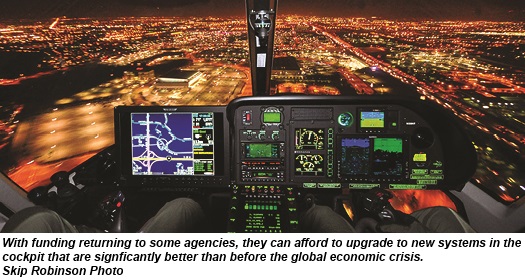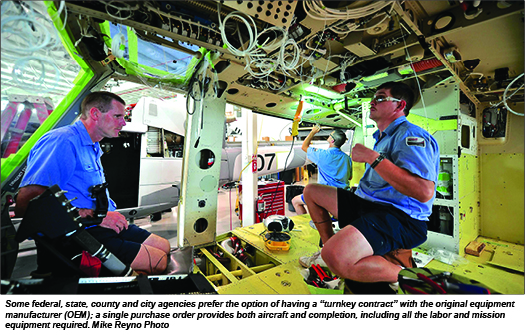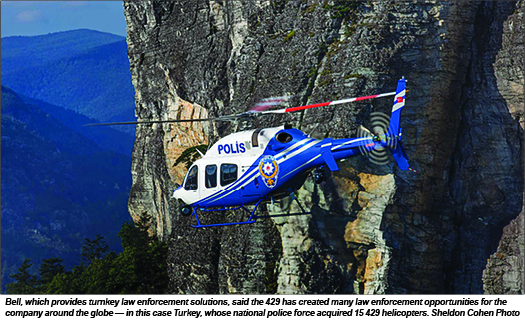
Since the turn of the millennium, the helicopter industry in general, and the airborne law enforcement community in particular, has certainly had an interesting ride. While airborne capabilities increased substantially in the wake of the 9/11 terrorist attacks, the 2008 global financial crisis — and the widespread austerity that followed — hit helicopter-flying law enforcement agencies particularly hard. Many struggled to stay airborne, resorting to fleet sales, or restricted flying hours, to enable them to navigate a course through evertightening budget restrictions.
But when Vertical spoke to a variety of helicopter completion companies about the current state of the law enforcement market and the types of completions they’re seeing, the general consensus seemed to be that the industry is on an upturn.
“As the economy recovers, we are seeing communities increase their funding of aviation programs and fund helicopter upgrades and new aircraft purchases,” said Frank Graham, senior director of global sales at United Rotorcraft, an Air Methods company, which has facilities in in Englewood, Colo., and Decatur, Texas.
The turnaround, he said, started about a year and a half ago — good news for helicopter manufacturers and the U.S.- based factory-owned and independent completion centers serving the law enforcement market.
Knowledgeable Customers
Milton Geltz, managing director of Metro Aviation in Shreveport, La., said most law enforcement agencies are very savvy about the systems and equipment they want to acquire for their airborne assets.
“The policing community is very collegial and agencies openly share information with each other,” he said. “Officers go to trades show, visit other operators, know what is available and what they want. And they work very hard to obtain the equipment they require.”
The opportunity for U.S. agencies to gain federal grant money to acquire this equipment can make all the difference.
“Some Homeland Security grants are to designed to enhance interoperability between various government agencies and cover refurbishment costs — or the purchase of a new system such as an HD camera, display and recorder,” said Tom Irmeger, director of sales and marketing at Wysong Enterprises in Blountville, Tenn.
The Homeland Security Grant Program has several components including the State Homeland Security Program, Urban Areas Security Initiative, and Operation Stonegarden to build, sustain, and deliver core security capabilities.
Ken Pilard, avionics manager at Carlsbad, Calif.-based Hangar One Avionics, said: “It’s getting a little bit more complex on the bidding side since some grant agencies require a competitive bid for even the most simple job. Today, you’ll often see half the funding for a helicopter upgrade coming from a federal grant and the other half being provided by a local agency.”

A Turnkey Solution?
While independent completion centers have traditionally been the go-to destinations for barebones “green” helicopters awaiting transformation into their mission-specific configurations, this trend does seem to be changing somewhat, providing the consumer with a greater variety of options.
“Companies like Bell and Eurocopter [now Airbus Helicopters] used to outsource a lot of completion work because they didn’t have the engineering capability and STCs [supplemental type certificates],” said Don Hubbard, director of technical support and program management at Rotorcraft Services Group (RSG) in Fort Worth, Texas.
However, those two companies are now major players in the completions business — Airbus Helicopters through an expansion of its capabilities, and Bell through its purchase of Edwards and Associates and concentration of its completion business in Piney Flats, Tenn. AgustaWestland, Enstrom, MD Helicopter, Robinson and Sikorsky also maintain some customization and completion capability in the U.S. that can be used for law enforcement aircraft.
Some federal, state, county and city agencies prefer the option of having a “turnkey contract” with the original equipment manufacturer (OEM); a single purchase order provides both aircraft and completion, including all the labor and mission equipment required.
Kris Long, delivery manager at Bell’s Piney Flats facility, said some of the advantages of having an OEM handle a completion are “quality, warranty, access to engineering data, specifications, and inspections.”
The company recently delivered 15 Bell 429s to the Turkish National Police. “The introduction of the Bell 429 has created several law enforcement opportunities globally and the Bell 412EPI is also generating interest,” said Long.
Independent Completion Centers
Many law enforcement and grant funding agencies favor competitive bids for aircraft purchases, retrofits and completions, to allow for greater public oversight.
“When a large agency goes out and buys 10, 20 or 30 aircraft, the OEMs are usually very competitive and will win the business,” said Metro’s Geltz. “However, the smaller shops are usually very price competitive and offer a lot of flexible and personal service when it comes to upgrades and completion work involving one, two, three or more ships.”
Hubbard highlighted the importance of the evaluation criteria in a competitive bid. “Does the agency automatically have to award the contract to the cheapest bidder?” he said. “Or is there room to consider how much experience a company has on an aircraft or doing specific kinds of integration jobs? Other factors that come into play are the geographic location of the completion shop and warranties.”
Geltz said other differentiators agencies should look for include the engineering, free-thinking, and problem solving skills of a completion center’s employees, as well as its ability to deliver a system that is relatively maintenance free, easy to access, and easily calibrated.
United Rotorcraft and Metro Aviation both have strong ties to the helicopter emergency medical services (HEMS) industry, providing a great deal of experience serving internal and external customers.
Companies like RSG, Wysong Enterprises and Hangar One Avionics all started life in the avionics or electronic newsgathering (ENG) business, which has served them well as the aviation and law enforcement world transitions from analog to digital systems.

A Changing Cockpit
In recent years, major helicopter OEMs and completion centers have been developing more glass cockpit upgrades. For example, Bell introduced the Garmin G1000H flight deck on the Bell 407GX, and back in 2010 RSG and Garmin teamed to obtain FAA STCs for installation of the Garmin G500H glass cockpit in the Airbus Helicopters AS350 B2, AS350 B3 and EC130 B4 models.
As more manufacturers offer glass as a primary display, there may be less need for completion centers to add such upgrades, but this will go hand in hand with a growing requirement to integrate various mission systems with OEMprovided glass displays.
Elsewhere in the cockpit, moving map systems have brought tremendous advances, while the next milestone will likely be as the U.S. transitions from a radar-driven navigation system to an ADS-B (Automatic Dependent Surveillance-Broadcast) -based system that uses highly accurate GPS signals to provide more precision than ever before.
Recent changes to the radio spectrum have also had an effect for airborne law enforcement agencies.
“All public safety radio systems had to move to at least 12.5 kHz efficiency technology on Jan. 1, 2013, and cease operating with 25 kHz technology radios,” said Wysong’s Irmeger. “The splitting of the spectrum [known as narrowbanding] allows the creation of additional capacity within the same radio spectrum to support more users.
“Helicopter systems . . . had to be replaced with new systems made by Technisonic and other manufacturers that offer a lot more capability in a compact package.”
New Mission Systems
You can almost say that “time stood still” in many helicopter cockpits when city and municipal budgets got particularly tight during the financial crisis.
“There were considerable advances in technology during the economic downturn that many agencies couldn’t afford to acquire,” said United Rotorcraft’s Graham. “Now the return of funding means that agencies can acquire new systems that are significantly better than what was available five years ago.”
From tip to tail, there have been huge technological advances in navigation and communication systems, instrument panels, searchlights, monitors, recorders, microwave downlinks, mapping and weather, HD imaging and night vision goggle (NVG) systems.
RSG’s Hubbard said that one of the main benefits of this new technology was better decision-making — both in terms of aviation and tactics — by pilots, tactical flight officers, and command centers.
“A helicopter equipped with a high definition camera in a FLIR Ultra 8500 or Wescam MX20 system can live stream very sharp images to a command center where they can be viewed on an 80-inch HD screen for high quality tactical decision-making,” he said.
“And with the Garmin GDL69 [which delivers XM WX Satellite Weather to a navigation system] you have an active weather system. That means that when you takeoff you can actually watch a front coming in and make a real-time decision where you are going to fly — [rather than doing so] three hours in advance.”

Highly integrated systems now provide the ability to overlay the street addresses and the names of building owners on HD and infrared video, speeding up decision-making and reducing the need to constantly toggle between screens — or have multiple displays. It’s also of huge benefit to police officers on the ground.
The extent of systems integration today means that a pilot or observer in any seat can bring up images or data on a multi-function display from any of the helicopters sensors, cameras or mapping systems to provide better situational awareness. Ease of use has also improved with the wider availability of touch screens.
Finally, the use of microwave downlinks to transmit real-time color HD video and infrared images is increasingly common.
“A couple of years ago, you started to see GPS mapping systems in police helicopters utilize 4G cellular networks for a two-way sharing of data between the aircraft and the ground,” said Frank Graham.
“Cellular networks can’t transfer the level of data today that can be carried over a microwave downlink, but in the future they may be able to transmit a heavier data package to the ground when the helicopter is in a pursuit.”
The act of integrating multiple systems is one of the challenges presented by this new technology.
“It’s more than connecting the right pin to the right pin in a piece of hardware,” says Wysong’s Irmeger. “There is a lot more work involved [in] configuring the software.”
Geltz said that while an HEMS completion might typically require three of four days of software programming for the various systems, it is quite common for it to take two weeks in a law enforcement completion — to ensure all the communications, audio, moving map and visual systems work together.
“One of the downfalls of all this new technology is that product changes occur quite frequently and the makers of these systems don’t usually communicate how their product changes will impact our systems integration,” he added.
One area where aircraft technology has not kept up with consumer electronics is the availability of aviation-certified high-resolution screens, said Geltz.
An Exciting Future
In looking at what may still lie ahead, it’s easy to forget just how far we’ve already come, such as in the extraordinary development of capability in law enforcement videography.
“You used to have to hook up a visual system to a Sony Handicam to record to a 8 mm tape if you wanted a record of what the helicopter camera was seeing,” said Geltz. “Now we are outfitting police helicopters with three solid-state recorders that capture everything a helicopter ‘sees’ and are designed to keep the data secure so it can be used as evidence in court.”
Today’s aerial law enforcement helicopters are a lot more than sophisticated eyes in the sky. They are becoming digital C4ISR (Command, Control, Communications, Computers, Intelligence, Surveillance and Reconnaissance) platforms capable of fighting crime in new ways.
Completion centers provide crime fighters with the assurance that the money they spend on their aviation assets will provide new aerial capabilities that are greater than the sum of their parts.





